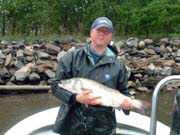In most seasons of the year, when boats plow through shallow water in the Meadowlands, the water ahead of the bow seems to bubble.
This phenomenon is not the stirring up of sediment from the muddy river bottom, but the movement of hundreds of inch-long fish called Killifish Mummichogs.
For years, these small fish have served as a kind of barometer of the river’s health, one of the lower rungs on the food chain feeding other larger fish as well as migratory birds.
When tabulations of the fish’s number last fall showed the population dropping, environmental scientists working for the New Jersey Meadowlands Commission had reason to cheer. This meant, according to the initial report done on a year-long study, that other larger fish and birds had returned in sufficient numbers to feed on the killifish, indicating that the Meadowlands – after decades of decline due to pollution, development and other negative factors – were finally on the rebound.
The study was conducted by the Meadowlands Environmental Research Center in conjunction with Rutgers University.
Two of the key people in the new survey were Senior Naturalist Brett Bragin of the New Jersey Meadowlands Commission and Dr. Kirk Barrett from Rutgers. The study was funded with $350,000 from the commission, and it involved setting up stations for capturing fish in 11 of the 14 municipalities in the Meadowlands district.
Prior studies
This is the first study done on the fish population since one conducted in 1987 when this section of the Hackensack River was considered nearly depleted of wildlife. Back then, more than 91 percent of the fish found were Killifish. In the new survey, slightly over 40 percent of the total catch were Killifish. White Perch, which were almost non-existent at 1.3 percent in 1987, blossomed to nearly 28 percent last year with similar dramatic results for striped bass and other fish caught. In fact, the surveyors caught more varieties last year than in 1987, up from 30 species to 36 in 2003. The study showed fish were larger than those caught in 1987.
“We’re redoing the work done in 1987,” Bragin said during a telephone interview, although he noted that there were a few differences in the study this year. “Last time, the fish were counted and some measured. This time we also weighed the fish we caught.”
“We wanted to determine whether or not the fish community was better or worse,” Bragin said. “Most people believed the water quality was better.”
Since 1987, the Meadowlands had seen dramatic cleanup efforts. Most of the trash dumps that had existed prior to that period were closed. Many of them sealed to keep from spreading half a century’s worth of poisons into the water. Preservation efforts were also underway, including restoration of wetlands in northern Secaucus.
Yet other changes were taking place in the Meadowlands that were the natural result of development over the years. For instance, prior to the construction of the Oradell Dam, most of the Meadowlands had fresh water flowing through it. But the dam’s construction early in the 20th Century made for gradual inroads of salt water, altering the ecology.
“In our collection, we used four kinds of commercial gear,” Bragin said. “And we took samples once a month at 21 locations.”
The first sample was taken in August 2001, and the study ended in July 2002. While the scientists tried to keep all the details consistent at each site and repeat as closely as possible the testing done in 1987, changes in the local geography forced them to shift one or two locations.
“It was actually more difficult in 1987,” Bragin said. “That sampling only had a three-person team. This time, we had our own truck dedicated to the study. We didn’t have to ask to borrow one.”
The overall improvement in the environment also made this study easier to conduct, Bragin said.
“In the past study, old tires, large pieces of timber, rail road ties and other things fouled up nets,” he said. “This time there was much less trash, fewer tires and less shredding of our nets.”
This report issued by the two men is only the first part, with additional details and firmer numbers due to be released later.
The 1987 study had 333 collections, resulting in a catch of 42,186 and of 30 species. The 2001-2002 study made 360 collections for about 29,000 fish. While the overall numbers of fish dropped significantly, the varieties of larger fish were greater with increased numbers of white perch, striped back wheat and blue fish.
Killifish have a high tolerance for pollution, Bragin said, explaining their high number in the earlier study, while the other larger fish do not, and the increased numbers of larger fish indicate a healthy environment overall.
Along with the fish count, the scientists also took water quality data, such as temperature of water, pH levels, and other details. Bragin called it a snapshot of current conditions, and hinted of a brighter future. He said that if there are improvements in the environment, “The sky is the limit” as to what kinds of waterfowl and other creatures might return, since nearly all the migratory birds that stop off in the Meadowlands feed on the fish.
Dr. Barrett said restoration of wetlands helped improve the fish population, noting that the common reed that has been spreading through many of the wetlands areas over the years had tended to reduce the available fish habitat. While these reeds have some benefit, they turn the wetlands into solid ground as they decay over the years. By returning the area to a more functioning wetlands, fish have a larger environment in which to spawn.
This increases the diversity in the fish community,” he said, noting that future fish studies could be done in five-year increments in order to get a better sense of the changes underway.
